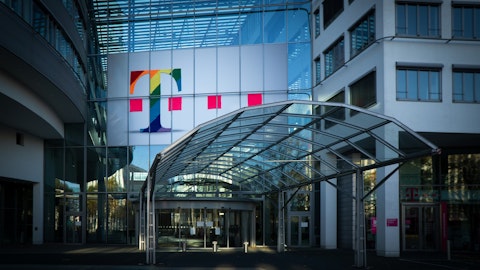América Móvil, S.A.B. de C.V. (NYSE:AMX) Q4 2023 Earnings Call Transcript February 14, 2024
América Móvil, S.A.B. de C.V. isn’t one of the 30 most popular stocks among hedge funds at the end of the third quarter (see the details here).
Operator: Good morning. My name is Candace, and I will be your conference operator today. At this time, I would like to welcome everyone to the América Móvil Fourth Quarter 2023 Conference Call and Webcast. [Operator Instructions] I would now like to turn the conference call over to Ms. Daniela Lecuona. Please go ahead.
Daniela Lecuona: Thank you. Good morning, everyone. Thank you for joining us today in our fourth quarter operating and financial review. We have on the line Mr. Daniel Hajj, CEO; Mr. Carlos Garcia Moreno, CFO; and Mr. Oscar von Hauske, COO.
Daniel Hajj Aboumrad: Good morning, everyone. Welcome to América Móvil’s Fourth Quarter of 23 financial and operating report. Carlos Garcia Moreno is going to make out the summary of the results. Carlos?
Carlos Garcia Moreno: Thank you, Daniel. Good morning, everyone. Well, the fourth quarter of 2023 turned out to be an extremely volatile one, with interest rates surging in the first month of the quarter to record highs not seen in over 16 years. This was in continuing with the trend that began early in the third quarter as inflation pressures brought about new increases in reference rates by the Fed. The yield of ten-year Treasury notes, which had stood as low as 3.75% in mid-July, shot up to 5% in exactly three months. But then things turned: new inflation readings appeared to be softer and the Fed put out the message that no new action on reference rates was expected for at least the remainder of the year. A huge rally in interest rates followed, with the ten-year Treasury yield plummeting back to where it had been in mid-July.
We added 3.9 million wireless subscribers in the quarter, including 2.7 million postpaid clients. Brazil contributed with 1.8 million new contract clients, while 329,000 came from Austria, 124,000 from Argentina and 109,000 from Mexico. The prepaid platform registered net additions of 1.3 million clients in the period with Colombia gaining 456,000, Mexico 308,000, Argentina, 278,000 and Central America roughly the same amount, 269,000. On the fixed line segment, we obtained 386,000 broadband accesses. Mexico was the leader, adding 165,000 accesses, followed by Brazil with 60,000 and Argentina with 51,000. Looking at the base, the postpaid base was the most dynamic one, increasing 7% year-on-year, followed by fixed broadband accesses, which were up 4.1%.

Prepaid subscriber base rose 1.2%, while Pay TV accesses fell 1.8% year-on-year. At constant exchange rates, service revenue was up 3.7%, in line with the pace registered in the prior quarter. For as adjusted EBITDA reaccelerated to a 4.6% recurrent in the quarter. So we basically maintain the pace that we had on service revenue from the third quarter, and we managed to reaccelerate adjusted EBITDA to a 4.6%. Mobile service revenue expanded 4.2%, much in line with the prior quarter, and that’s on the Fixed-line platform grew 3.0%, continuing the accelerated trend of sales throughout the year. This was the fifth consecutive quarter with positive growth on both platforms and ensure that for the full year 2023, revenue increased on the 2 platforms, mobile and fixed.
Mobile service revenue growth remained stable in Mexico at 4.5%, whereas in Brazil it slowed down from the prior quarter to 7.1%. In Central America, mobile service revenue growth accelerated to 10.7% that you can see in the chart. Revenue from corporate networks led the way on the fixed-line platform, expanding 8.1% from the year-earlier quarter, followed closely by broadband revenue that posted a 6.6% increase. PayTV revenue declined slightly, 1.1%, its smallest decline in over a year. Corporate networks revenue growth was strongest in Eastern Europe, again, you can see this on the chart, 30.2%; Colombia, 21.6%; Ecuador, 19.5%; and Mexico and Peru, with slightly more than 14% each. In Central America it accelerated to 6.6%, having posted every quarter over the last year faster growth rates than the preceding one.
Now importantly, Argentina has gone through a period of high inflation the last several years. Since 2019 it has been subject to the accounting guidelines applicable to hyper-inflationary countries, with all the accounting variables expressed in real terms at constant Argentine pesos. For consolidation purposes in our financial statements, with no other economy considered hyper inflationary within America model; those Argentine figures expressed in constant Argentine peso terms at the prevailing prices at the end of the period must be converted into Mexican pesos at the exchange rate observed at the end of the period, per IFRS rules. Given the magnitude of the Argentine peso depreciation, the application of the above-mentioned norm generates unusual effects.
In particular, as you can see on the slide as well, revenue actually decreases by 3.7 billion Pesos when Argentina is included in our results and EBITDA is also reduced by 1.4 billion pesos. We have completely unusual and counterintuitive situation whereby the inclusion of Argentina does not lead to adding a small amount or a smaller amount than what we had before, it actually leads to a net decline in revenues and EBITDA. Again, this is per the IFRS growth that we are subject to. Other than the above-mentioned unusual accounting effects, the inclusion of Argentina generates 8 billion pesos in foreign exchange losses and overall results in 8 billion pesos downward impact on net income to 16.8 billion pesos. So in the Argentina, we would have posted 28 billion pesos in net income, and siloed net income and with the use of Argentina go down.
So that’s basically what we had. Cash flow-wise, our net debt increased by 21 billion pesos, and complemented our operating cash flow, and it helped us cover our capital expenditures in the amount of 156 billion pesos, shareholder distributions totaling 40 billion pesos, of which 14 billion pesos were share buybacks and 11.8 billion pesos in labor obligations. So that’s the summary, and I would want to pass the floor back to Daniela.
Daniel Hajj Aboumrad: Yes. Thank you, Carlos, and I think we can start with the Q&A.
See also Top 20 Defense Contractors in 2024 and 20 Fastest Growing Technology Companies in the US.
Q&A Session
Follow America Movil S A B De C V (NYSE:AMX)
Follow America Movil S A B De C V (NYSE:AMX)
Operator: Thank you. [Operator Instructions]. Our first question comes from the line of Vitor Tomita of Goldman Sachs.
Vitor Tomita: Two questions from our side. The first one would be on the CapEx side. If you could give us an update on your plans for CapEx and if you plan to maintain that 2022 -2024 CapEx envelope of $24 billion after some higher CapEx in 2023? And the second question from our side would be on Colombia, if you would have any comments on recently announced regulatory changes in Colombia and on how that might affect your strategy for that country?
Daniel Hajj Aboumrad: Well, the first question, if we look at the last 3 years, ’21, ’22 and ’23, we invest around $25 billion. So what we do with this $25 billion, we do a lot capacity in 4 and 4.5G. We do 5G in a lot of countries, let’s say, in Brazil, we have more than 200 cities with 5G in Mexico, more than 120 cities. And all around, we are doing 5G where we have — we buy a spectrum in these last 3 years. In some submarine cables that we need to have redundancy and to have more capacity for data. We do home passes, a lot more home passes all around Latin America. We changed our copper, old copper. We do a lot of fiber, and we do also fiber on Greenfields. And in the B2B, we increased our capacity, more data centers, and we’re growing revenues, very good revenues growing in B2B.
So we are — I think we are in a very good shape right now with all the investments that we have been doing the last 3 years and the last 5 years because we have been investing this amount of money. So what we’re seeing this year is that we have the capacity to reduce the CapEx for this year. And what we have last year of $8.6 billion of CapEx, we are going to reduce this year for, to do $7 billion on CapEx. That’s what our budget give us. We still want to be doing and growing in every country in Latin America and Europe and developing still fiber and growing also in 5G in some countries where we don’t have. And with all of that, the CapEx that we have for this year is 7 billion, so a good reduction from last year is the CapEx that we projected for 2024.
In Colombia, we have some changes in the regulatory side. We don’t like to have more — all the countries are taking out regulatory measures because what they want is investments. And in Colombia, we’re having a little bit more regulatory obligations to do. But while in Colombia, we’re going to still invest. We’re reviewing very deeply how they are going to hit us. And — but we are still maintaining our investments in Colombia and growing. We get the frequencies in 5G last year. We’re going to put 5G in this year. And I think the competition is strong, a lot of promotions things happening in the market. So we are still very strong in Colombia, and we’re going to still invest what we need to invest there.
Vitor Tomita: Very clear. Thank you very much.
Operator: Our next question comes from the line of Walter Piecyk of LightShed.
Walter Piecyk: The Movil ARPU growth has been pretty steady in Mexico. I’m just curious if that can sustain going forward. Also, I see Brazil had some growth. And on Colombia, are there lessons learned there that things that you’re doing in Mexico and Brazil to, I guess, either increase usage or otherwise get people on postpaid, whatever the factors are that are driving that ARPU growth that can be implemented in Colombia?
Daniel Hajj Aboumrad: Well, first, in Mexico. In Mexico, we’re growing our ARPUs like 3.1% more in prepaid than in postpaid. And it’s related — we haven’t increased prices in Mexico. Our customers are sometimes upgrading our plans, and that is what’s giving us all contracts in new and higher plans with 5G. So 5G is helping us to increase the ARPU in Mexico. And well, that’s what people is using more data. So that’s what is happening. So 3.1% increase in ARPU, I think it’s good because in Mexico, we have the highest ARPUs there. In Colombia, what is happening in the last 2, 3 years is a lot of competition with all these new competitors are giving a lot of data in their plans. So what is happening is that with all these data, you need to do better plans also and sometimes our customers are downgrading because they have less rent with more data on the actual plan.
So what I think that’s already finished. I think it’s been finished in mid of last year. And I hope that this year, we can increase in Colombia ARPUs. And in Brazil, in Brazil, we’re doing very good in ARPUs growing 7%, increasing our postpaid base, growing a lot machine-to-machine also doing good in corporate. And well, that’s — we already consolidate all the subscribers of oil. I think it was very good the way we consolidate. We are gainers in number portability. So we’re gaining market share in Brazil.
Walter Piecyk: And then for the CapEx, the 8-6 million that you mentioned, a portion of that, I guess, is how you would describe purchase of intangible assets. I’m not sure if that’s spectrum or software. So when you think about the 8-6 million — what’s the general mix of spectrum or software versus true telco infrastructure or fiber? And then is the reduction from 8-6 to 7 really just the drop-off of just not having spectrum or intangible asset purchases? Or is there — if you could just give a little bit more detail on the elements of what’s in the 8-6 and the 7.
Daniel Hajj Aboumrad: I don’t have, I don’t have exactly the detail on that. But I think on the spectrum, we already get the spectrum. What we need. I think the only thing that we have for this year is to renew the spectrum of Ecuador and maybe 2 or 3 other countries, small countries on the spectrum, but Argentina, Mexico, Colombia, Brazil, we already get all the spectrum there. So the reduction that we’re going to have this year is in what I already said is wireless infrastructure, fixed line infrastructure, transport networks, IT. IT, it’s going to be more or less the same for transport because we already do — we have been putting, let’s say, fiber to the node photonic; also we already do all the photonics needs all the new technologies for the backbone and transport.
So all of that, we already do a big part of that to allow us to reduce the CapEx on new sites, 5G sites, home passes, greenfield and brownfield because we changed a lot of our copper, that old copper that we have. In the variable, there’s part in the CapEx that is variable means the same depending on the sales that you have. And that will be more or less the same because we think that we still can grow this year as we grow last year. So even we have a better budget for broadband, fixed broadband for this year than for last year. And in the spectrum, as I said, the big thing that we have for this year is more on Ecuador to renew the spectrum on Ecuador. So the 700 megahertz we — that we bought in Colombia and Argentina was in 2023. Mexico, we already have before and Brazil already.
So the year, we don’t see any important spending on the spectrum besides Ecuador for this year. So all of that allow us to reduce the CapEx to 7 billion.
Walter Piecyk: Okay. If I could get one more. Just — if not, you can just move on to the next caller, but Telekom Austria, is this really an essential asset to keep in the portfolio? If you think about the longer term if you have an opportunity perhaps to exit that market and remain focused in Latin America. Just give me a refreshed thoughts because obviously, revenue is not growing there on the Movil side. So just curious your thoughts on the importance of Telekom Austria going forward.
Daniel Hajj Aboumrad: Well, I think Telekom Austria came with all the Eastern Europe countries. And I think we’re growing good in all these countries. Look, these countries are more or less the same size as Austria. We’re growing very good. And I think we can grow a little bit more on Austria. No, we don’t want — we want to stay with the company. We bought some shares, I think, 8% more last quarter we already have like 60%, if I remember exactly 59-point-something percent, we used to have [Indiscernible] were increasing, and we feel very comfortable, very good cash flow company, Carlos…
Carlos Garcia Moreno: I think it is important also, Walter to mention that the country has been fully deregulated after having been subject to a symmetric regulation for about 30 years. And a little bit what Daniel is mentioning, they want to drive more investment into the sector. I think that that there’s a lot to be done still on the fixed line side on fiber. There’s still a lot to grow on fiber. But it’s a very good market, B2B excellent. We are providing a lot of services not only into Austria, but also out of Austria into Eastern Europe and into Germany, for instance, which is very order and it’s been going surprisingly well. So I think that there’s many very positive things that we can say about the overall investment in Europe on Austria in Europe.
Operator: Our next question comes from Marcelo Santos of JPMorgan. Please go ahead.
Marcelo Santos: I have 2. The first question would be on Mexican broadband. Could you talk a bit more about the nature of the strong print in Mexican broadband adds? What is it more on higher gross adds or lower churn? Is there a regional angle or some areas growing faster than others? So I just wanted to understand a bit more this very good broadband add in Mexico. And the second question is on CapEx. Very clear that the CapEx for this year should be $7 billion. Is this a good indication for the years to come? Do you think that is a sustainable level for the coming years, around 7 billion…
Carlos Garcia Moreno: Yes, about Mexico broadband. As we mentioned before, we’ve been pushing pretty hard the migration from copper to fiber — and now 81% of the customers are already connected with fiber 81%. So we really cover all the customer base with fiber to the home. Secondly, we’ve been launching in the market a very, very unique packages with speeds symmetrical speeds that bring value to our customers. And secondly, we did some packages that include streaming video platforms included in the broadband, has been very well accepted in the market. So — and another part is that we change all the processes of installation and repair to have a better customer experience is why we got a very good net adds. And we believe that we will still continue to getting a good proportion of the net adds this year.
Daniel Hajj Aboumrad: And on the CapEx, it’s too early to say something right now. I think we’re going to do the 7 billion. I think for next year, we don’t see also big spendings on the spectrum also. So — and let’s see, with all these technologies, new technologies that we have been putting all the digitalization, I think we are this year in very good shape. I don’t know for next year, but I — what I can tell you is that we have the best network by far in Latin America, all around Latin America, and that gives us a good advantage right now — we do big investments, good investments.
Operator: Our next question comes from the line of Andrew Sellers of UBS. Please go ahead…
Unidentified Analyst: Hi, everyone. The first one is about margin in Mexico. I know you had some one-timers next quarter. But do you see the margin expanding closer to what we had in 2022 fourth quarter and which factors could drive this potential expansion? I just want to know how the company is feeling about our current levels of margin in Mexico EBITDA? And the second question is about Argentina. So besides the translation effect, what other factors are you guys monitoring in the country. I’m talking about profit here, such as the fact for your customers, maybe higher the legacy rates or lower frequency of charges to pay is going to do an agency..
Daniel Hajj Aboumrad: Yes, we cannot hear your question. your line is not so good, Andre. I’m sorry.
Unidentified Analyst: Yes. Yes. The first question is about margin. Sorry about that. But the first question is about margin in Mexico — if you have market margin…
Daniel Hajj Aboumrad: Well, the margin in Mexico is just the same as last year. I think we have a very good margin over 40. And I can tell you that in Mexico, it’s a lot of promotions, big competition in mobile and in fixed. And what we’re doing is we are really cutting costs, doing a lot of digitalization for the cost side and having good plans and that’s more or less what we’re doing. I think we can sustain this margin for next year. We are growing in Mexico, something that it’s been very good in 2023 against 2022 is our postpaid basis starting to grow very good in 2023. So that allow us to have better customers, high ARPU customers. So that’s something that is doing good in Mexico.
Carlos Garcia Moreno: Only to add to what Daniel is saying, I think it’s important to focus on the adjusted EBITDA metric. If you correct for the sale of Telmex towers that took place in the last quarter of 2022. Then the margin collected for this was 40.2%. It has increased for the year to 40.6%. — on that basis. So we had an increase of margins in Mexico. And I think that we will continue to increase in this question.
Daniel Hajj Aboumrad: And on Argentina, I don’t know what’s your question on Argentina.




